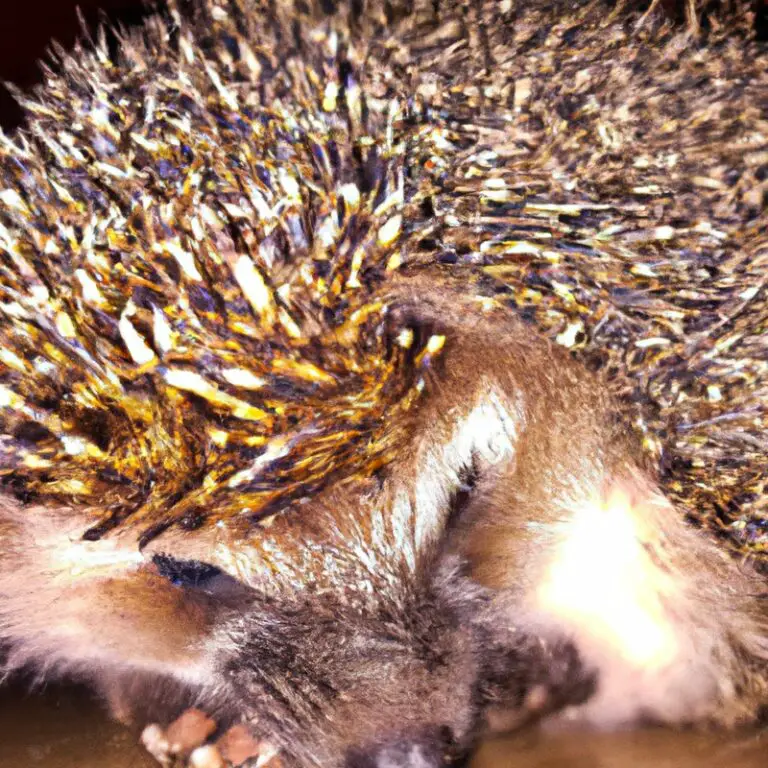How To Create a Hedgehog-Friendly Landscaping Design?
Key Takeaways:
- Provide shelter and hiding spots for hedgehogs by incorporating dense vegetation and log piles into your landscaping design.
- Create a hedgehog-friendly feeding area by leaving out food and shallow dishes of water on a regular basis.
- Minimize the use of pesticides and chemicals in your garden to protect the health of hedgehogs and their food sources.
- Install hedgehog-friendly fencing to allow these creatures to roam freely between neighboring gardens.
Are you tired of having a mundane and ordinary garden? Are you looking to transform your outdoor space into a haven for nature and wildlife?
Well, look no further because we have just the answer for you – a hedgehog-friendly landscaping design! Creating a garden that is welcoming to hedgehogs not only adds a touch of charm and beauty but also provides a range of benefits.
From promoting biodiversity to enhancing pest control, there are countless reasons why you should consider incorporating hedgehog-friendly elements into your landscape. In this article, we will delve into the essential elements, strategies, and maintenance tips that will help you create a hedgehog haven right in your backyard.
So, let’s get started and make your garden a hedgehog’s dream!
| Aspect | Hedgehog-Friendly Landscaping Design |
|---|---|
| Safety | Ensure there are no exposed hazards such as sharp objects or toxic plants. Provide escape routes like small gaps in fences. Avoid using pesticides or chemicals. |
| Shelter | Include areas with dense vegetation, such as shrubs or bushes. Create piles of leaves or branches to provide hiding spots. |
| Food | Plant native flowers and plants that attract insects and provide natural food sources. Install a shallow water source like a shallow bowl or pond for drinking. |
| Connectivity | Design a wildlife-friendly garden with hedgehog highways or small holes in fences to allow hedgehogs to roam freely between gardens. Create wildlife-friendly corridors to connect green spaces. |
| Minimize Disturbances | Avoid excessive lighting or loud noises in the garden. Limit the use of machinery or tools that may startle or harm hedgehogs. |
| Extra Features | Add a hedgehog house or nesting box. Provide a log or stone pile for hibernation. Minimize tidy areas to allow for natural habitats. |
Benefits of Creating a Hedgehog-Friendly Landscaping Design
Creating a hedgehog-friendly landscaping design has several benefits, including promoting biodiversity and encouraging natural pest control. Additionally, it enhances the aesthetic appeal of your outdoor space.
Promoting Biodiversity
Promoting biodiversity is essential for maintaining a healthy ecosystem. You can support biodiversity in your landscaping design by incorporating a variety of native plants.
These plants provide food and habitat for different species, attracting birds, insects, and other wildlife.
Avoiding the use of pesticides and chemicals will also protect the biodiversity of your garden. By creating a diverse and natural environment, you can contribute to the preservation of local ecosystems and enhance the overall biodiversity in your area.
Encouraging Pest Control
To encourage pest control in your garden, create a habitat that attracts natural predators like birds, ladybugs, and toads. Plant native flowers and herbs to attract beneficial insects like bees and butterflies.
Avoid using chemical pesticides, as they can harm the beneficial organisms.
Regularly remove weeds and debris to eliminate hiding places for pests. Implement physical barriers like nets and fences to protect vulnerable plants.
By creating a balanced ecosystem, you can help control pests naturally.
Enhancing the Aesthetic Appeal
Creating a hedgehog-friendly landscaping design not only benefits the environment but also enhances the aesthetic appeal of your outdoor space.
Here’s how you can spruce up your garden while considering hedgehog needs:
- Choose native plants that attract pollinators and provide food sources for hedgehogs.
- Add variety to your landscaping by incorporating different textures, heights, and colors of plants.
- Install natural features like log piles, rockeries, and water sources to create a more visually interesting space.
- Create cozy sheltered areas with dense shrubs or hedges, which can also act as a safe haven for hedgehogs.
- Consider incorporating decorative elements like pathways, fences, or trellises to add structure and visual interest to your garden.
Understanding the Habits and Needs of Hedgehogs
To create a hedgehog-friendly landscaping design, it’s important to understand their habits and needs.
This involves creating a safe and sheltered environment and providing adequate food and water sources.
Creating a Safe and Sheltered Environment
Creating a safe and sheltered environment for hedgehogs is essential. To achieve this, ensure there are no hazardous elements like chemicals or sharp objects in the area.
Provide natural shelters such as brush piles or log piles where they can hide and feel protected.
Keep your garden well-maintained with trimmed hedges and bushes to avoid any entanglement or injury to the hedgehogs. Water sources like shallow dishes can also be provided for them.
Taking these steps will contribute to the well-being of these delightful creatures.
Providing Adequate Food and Water Sources
To create a hedgehog-friendly landscaping design, it is important to provide adequate food and water sources. Hedgehogs primarily eat insects, so include areas with dense vegetation to attract insects as a natural food source.
Leave water bowls or shallow dishes of water in your garden for hedgehogs to drink from.
Avoid using chemicals or pesticides in your garden to ensure that the food and water sources remain safe for hedgehogs.

Essential Elements for a Hedgehog-Friendly Landscaping Design
To create a hedgehog-friendly landscaping design, there are a few essential elements to consider.
Native Plants and Wildflowers
Native plants and wildflowers are great additions to a hedgehog-friendly landscaping design.
They provide natural sources of food and shelter for hedgehogs, supporting their survival and attracting them to your garden.
Consider planting a variety of native plants and wildflowers that bloom at different times of the year to ensure a continuous supply of nectar and seeds.
Examples include lavender, blackberry bushes, and wild primrose.
Avoid using pesticides or herbicides, as these can harm hedgehogs and their food sources.
Hedgehog-Friendly Hedges and Fencing
Hedgehog-Friendly Hedges and Fencing:
- Choose hedges that are dense and provide shelter and protection for hedgehogs.
- Opt for native species that offer a variety of food sources.
- Avoid using wire or netting in your fencing, as hedgehogs can get entangled.
- Ensure your fences have hedgehog-sized gaps to allow them to move freely.
- Consider creating hedgehog highways by removing sections of fencing to connect neighboring gardens.
- Regularly check hedges and fences for any hazards or damage that could harm hedgehogs.

Creating Hedgehog Highways
Creating Hedgehog Highways To create hedgehog-friendly landscaping, it’s important to establish hedgehog highways. These are passageways that connect different areas of your garden or neighborhood, allowing hedgehogs to move freely and find food, shelter, and mates.
Here’s how you can create hedgehog highways:
- Remove barriers: Clear away fences, walls, and other obstacles that prevent hedgehogs from accessing different garden areas.
- Create small holes: Dig a 5-inch hole at the bottom of garden fences or walls to allow hedgehogs to pass through easily.
- Connect green spaces: If possible, work together with neighbors to create a network of hedgehog highways that span across multiple gardens or green spaces.
- Provide cover: Place leaf piles, log piles, or brushwood along the hedgehog highways to provide shelter and hiding spots.
- Avoid using chemicals: Choose hedgehog-friendly pest control methods and avoid using pesticides or slug pellets that can harm these creatures.
Remember, creating hedgehog highways is a simple yet effective way to support these adorable spiky creatures and enhance their habitat in urban environments.
Strategies for Implementing a Hedgehog-Friendly Landscaping Design
To create a hedgehog-friendly landscaping design, there are a few key strategies to consider. These include minimizing the use of pesticides and chemicals, creating sheltered areas with woodpiles and compost bins, and building hedgehog houses.
Minimizing the Use of Pesticides and Chemicals
To minimize the use of pesticides and chemicals in your landscaping design, there are several effective strategies you can employ.
Firstly, focus on promoting healthy soil by enriching it with compost and organic matter.
This will create a robust ecosystem that can naturally resist pests and diseases.
Secondly, consider using natural pest control methods, such as companion planting and attracting beneficial insects.
Additionally, practice proper maintenance techniques, such as regular pruning, to prevent the spread of pests.
Remember, a pesticide-free landscape is not only better for hedgehogs, but also for the overall health of your garden.
Creating Sheltered Areas with Woodpiles and Compost Bins
Creating sheltered areas with woodpiles and compost bins is an effective way to attract and provide habitat for hedgehogs in your landscaping design.
These areas offer a safe and cozy space for hedgehogs to rest, hibernate, and raise their young.
Woodpiles provide cover and nesting material, while compost bins offer warmth and food sources.
To create these areas:
- Stack logs and branches in a quiet corner to form a woodpile.
- Ensure the woodpile is stable to avoid accidents.
- Place a compost bin in a shaded area and add organic waste regularly.
- Keep the compost bin secure to prevent predators from accessing it.
Building Hedgehog Houses
Building hedgehog houses is a great way to provide these nocturnal creatures with a safe and cozy shelter in your garden.
Here are a few simple steps to get you started:
- Find a suitable spot in your garden, preferably a quiet and undisturbed area.
- Use natural materials like logs, leaves, and straw to create a sturdy and insulated structure.
- Ensure that the entrance is small enough to keep out predators but large enough for a hedgehog to enter comfortably.
- Add a layer of dry leaves or straw inside the house to create a warm bedding area.
- Place the house in a shady area, facing away from prevailing winds.
Remember to regularly check and clean the hedgehog house, especially during winter months when hedgehogs may choose to hibernate inside.
By providing this simple accommodation, you can contribute to the conservation of hedgehog populations in your area.
Maintenance Tips to Sustain a Hedgehog-Friendly Landscaping Design
To sustain a hedgehog-friendly landscaping design, there are a few key maintenance tips you should keep in mind.
Regular Planting and Pruning
Regular planting and pruning are essential for maintaining a hedgehog-friendly landscaping design.
When it comes to planting, choose native plants that provide food and shelter for hedgehogs.
Avoid using pesticides or herbicides that can harm hedgehogs.
Pruning should be done regularly to ensure that plants don’t become overgrown and dense.
This allows hedgehogs to navigate through the landscape more easily.
Additionally, removing any dead or decaying plants can help prevent the spread of diseases.
By regularly planting and pruning, you create a welcoming environment for hedgehogs in your garden.
Maintaining Clean and Accessible Water Sources
To maintain clean and accessible water sources for hedgehogs in your landscaping design, consider these tips:
- Install a shallow, sloping water dish that hedgehogs can easily access and exit.
- Place the water source in a quiet and safe location, away from loud noises and potential predators.
- Regularly clean the water dish to prevent the growth of algae or bacteria that may be harmful to hedgehogs.
- Provide fresh water daily, especially during hot or dry weather, to ensure hydration for hedgehogs.
- Avoid using chemicals or pesticides in the vicinity of the water source, as this can inadvertently contaminate the water and harm hedgehogs.
Remember, providing clean and accessible water is essential for hedgehog well-being, especially during warm seasons when water can be scarce.
Monitoring and Addressing Potential Hazards
When creating a hedgehog-friendly landscaping design, it’s important to monitor and address potential hazards.
Here’s what you can do:
- Check for gaps in fences or walls that hedgehogs could get stuck in. Repair them or create hedgehog-sized gaps to allow them to pass through.
- Clear away any litter, garden tools, or other objects that could pose a threat to hedgehogs, such as getting tangled or injured.
- Be cautious with chemicals like pesticides, herbicides, and slug pellets, as they can be toxic to hedgehogs. Opt for natural alternatives whenever possible.
- Ensure there are no uncovered drains or holes in the ground that hedgehogs could fall into. Cover or block these areas to prevent accidents.
- Avoid using netting or wire mesh near ground level, as hedgehogs can easily become entangled. If you need to use these materials, raise them a few inches off the ground.
- Create safe passages by removing steps or creating gentle slopes in areas where hedgehogs might struggle to navigate.
By monitoring and addressing potential hazards, you can help protect hedgehogs and create a safe environment for them to thrive in your garden.
Frequently Asked Questions (FAQs)
What do hedgehogs eat?
Hedgehogs are insectivores, which means they primarily eat insects.
They have a diverse diet that includes beetles, worms, slugs, snails, and caterpillars.
Hedgehogs are also known to eat small vertebrates like frogs and mice, as well as fruits and plants.
It’s important to provide them with a balanced diet to support their health.
Avoid feeding them salty or sugary foods, as these can be harmful to their well-being.
Ideally, you should consult with a hedgehog specialist to ensure you’re providing the right diet for your hedgehog.
How can I attract hedgehogs to my garden?
To attract hedgehogs to your garden, create a welcoming and safe environment for them. Provide a variety of natural habitats such as log piles and bushes for shelter.
Keep your garden pesticide and chemical-free to avoid harming them.
Leave out water dishes and provide hedgehog-friendly food like wet cat food or specialized hedgehog food. Install a hedgehog house for them to hibernate or nest in.
Finally, create small gaps in your garden boundary to allow hedgehogs to roam freely.
Are hedgehogs harmful to other animals or plants?
Hedgehogs are generally not harmful to other animals or plants. They are insectivores, meaning their diet consists mainly of insects such as beetles, snails, and caterpillars.
They can also eat small vertebrates like frogs or mice, but this is less common.
As for plants, hedgehogs do not typically eat them or cause damage to them. In fact, their presence in your garden can be beneficial as they help control insect populations.
So, having hedgehogs around can actually be quite beneficial for your garden ecosystem.
Can hedgehogs be kept as pets?
Hedgehogs can be kept as pets. They are adorable creatures with unique personalities.
However, owning a hedgehog requires commitment, knowledge, and the right set-up.
Hedgehogs need a proper enclosure with plenty of space, hiding spots, and a wheel for exercise. They require a specific diet consisting of high-quality cat food, insects, and fruits.
Regular handling and socialization are important to build a bond with your hedgehog.
Veterinary care is also necessary to ensure their well-being. It’s crucial to do your research and understand the responsibilities before bringing a hedgehog home.
What should I do if I find a hedgehog in distress?
If you find a hedgehog in distress, it is important to act quickly and responsibly.
Here are the steps you should follow:
- Assess the situation: Take a moment to observe the hedgehog’s behavior and surroundings. Look for any obvious signs of injury or distress.
- Create a safe environment: If the hedgehog is in immediate danger, carefully move it to a safer location nearby, away from busy roads or potential threats.
- Handle with care: Use gloves or a towel to avoid direct contact with the hedgehog, as they may carry parasites or diseases. Gently scoop it up, supporting its body, and place it in a secure box or carrier.
- Provide warmth: Hedgehogs may suffer from hypothermia, especially if they are weak or injured. Place a warm, but not hot, cloth or heating pad in the carrier to provide some comfort.
- Contact a wildlife rescue organization: Reach out to a local animal rescue center or wildlife rehabilitator who specializes in hedgehogs. They will be able to provide further guidance and care for the hedgehog.
Remember, it is best to leave the handling and care of distressed hedgehogs to professionals who are trained in their welfare.
Offering temporary assistance and seeking expert help is key to ensuring their well-being and survival.
Final Verdict
Creating a hedgehog-friendly landscaping design not only benefits these adorable creatures but also promotes biodiversity, encourages natural pest control, and enhances the overall aesthetic appeal of your outdoor space.
By understanding the habits and needs of hedgehogs, providing a safe environment, and ensuring adequate food and water sources, you can create an ideal habitat for these spiky garden visitors.
Essential elements such as native plants, hedgehog-friendly hedges, and creating hedgehog highways are key to a successful design.
Strategies like minimizing pesticide use, creating sheltered areas, and building hedgehog houses are crucial for implementation.
Regular maintenance, including planting and pruning, maintaining water sources, and monitoring potential hazards, sustains the hedgehog-friendly design.
By following these guidelines, you can attract hedgehogs to your garden, minimize harm to other animals or plants, and even potentially help hedgehogs in distress.
Embrace a hedgehog-friendly landscaping design and contribute to the protection of these fascinating creatures and the preservation of our natural world.







